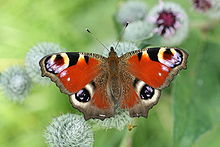- Inachis io
-
European Peacock Scientific classification Kingdom: Animalia Phylum: Arthropoda Class: Insecta Order: Lepidoptera Family: Nymphalidae Tribe: Nymphalini Genus: Inachis
Hübner, 1819Species: I. io Binomial name Inachis io
(Linnaeus, 1758)Synonyms Nymphalis io
Papilio ioThe European Peacock (Inachis io), more commonly known simply as the Peacock butterfly, is a colourful butterfly, found in Europe, temperate Asia as far east as Japan. It is the only member of the genus Inachis (the name is derived from Greek mythology, meaning Io, [the daughter] of Inachus). It should not be confused or classified with the "American peacocks" in the genus Anartia; these are not close relatives of the present species. The Peacock butterfly is resident in much of its range, often wintering in buildings or trees. It therefore often appears quite early in spring. The Peacock butterfly has figured in research where the role of eye-spots as anti-predator mechanism has been investigated.[1]
In the British Isles, the butterfly is found in England, Scotland (including Orkney and Shetland), Wales and Ireland. The Peacock is expanding its range.[2][3] The butterfly is not known to be threatened.[2]
Contents
Characteristics
The butterfly has a wingspan of 50 to 55 mm. The base-colour of the wings is a rusty red, and at each wingtip it bears a distinctive, black, blue and yellow eye-spot. The underside is a cryptically coloured dark-brown or black. There are two subspecies, I. io caucasica (Jachontov, 1912) found in Azerbaijan and I. io geisha (Stichel , 1908) found in Japan and the Russian Far East.
Natural history
The Peacock can be found in woods, fields, meadows, pastures, parks, and gardens, and from lowlands up to 2,500 metres (8,200 ft) elevation. It is a relatively common butterfly seen in many European parks and gardens. The Peacock male exhibits territorial behaviour, in many cases territories being selected en route of the females to oviposition sites.[4]
The butterfly hibernates over winter before laying its eggs in early spring, in batches of up to 400 at a time.[3] The eggs are ribbed and olive-green in colour and laid on the upper parts, and, the undersides of leaves of nettle plants[5] and hops. The caterpillars, which are shiny black with six rows of barbed spikes and a series of white dots on each segment, and which have a shiny black head, hatch after about a week. The Chrysalis may be either grey, brown or green in colour and may have a blackish tinge.[5] The caterpillars grow up to 42 mm in length.
The recorded foodplants of the European Peacock are Stinging Nettle (Urtica dioica), Hop (Humulus lupulus) and the Small Nettle (Urtica urens).[3]
The adult butterflies drink nectar from a wide variety of flowering plants, including buddleia, willows, dandelions, wild marjoram, danewort, hemp agrimony, and clover; they also utilize tree sap and rotten fruit.
The butterfly has cryptic undersides with flashy eye-spots above and can also make an audible sound by rubbing its wings together, presumably as anti-predator measures.[3]
Etymology
Io is a figure in Greek mythology She was a priestess of Hera in Argos.
-
Peacock caterpillars feeding on nettles.
See also
- Anglewing butterflies.
References
- ^ Stevens, Martin (2005). "The role of eyespots as anti-predator mechanisms, principally demonstrated in the Lepidoptera". Biological Reviews 80 (4): 573–588. doi:10.1017/S1464793105006810. PMID 16221330. http://journals.cambridge.org/action/displayAbstract?aid=344947. Retrieved 11 November 2010. (Abstract)
- ^ a b "Peacock". A-Z of Butterflies. Butterfly Conservation. http://www.butterfly-conservation.org/Butterfly/32/Butterfly.html?ButterflyId=11. Retrieved 13 November 2010.
- ^ a b c d Eeles, Peter. "Peacock - Inachis io". UK Butterflies. http://www.ukbutterflies.co.uk/species.php?vernacular_name=Peacock. Retrieved 11 November 2010.
- ^ Price, Peter W. (1997). Insect ecology (3rd (illustrated) ed.). John Wiley. p. 405. ISBN 9780471161844. http://books.google.co.in/books?id=rrzc-IkgNx0C&lpg=PA406&dq=territorial%20behaviour%20of%20inachis%20io&pg=PA406#v=onepage&q&f=false. Retrieved 11 November 2010.
- ^ a b Stokoe, W.J. (1966). The Observers Book of Butterflies. The Observer's Books (Fully ilustrated ed.). London: Frederick Warne & Co. pp. 191.
Further reading
- Baker, R. R. (1972). "Territorial Behaviour of the Nymphalid Butterflies, Aglais urticae (L.) and Inachis io (L.)". Journal of Animal Ecology 41 (2): 453–469.
External links
- Peacock Photosynth Photosynth of Peacock Butterfly
- Peacock page from the UK Butterflies site
- Peacock page from the Butterfly Conservation site
- Inachis io, Arkive
Categories:- Nymphalini
- Butterflies and moths of Europe
- British butterflies
- Fauna of Pakistan
- Animals described in 1758
Wikimedia Foundation. 2010.






